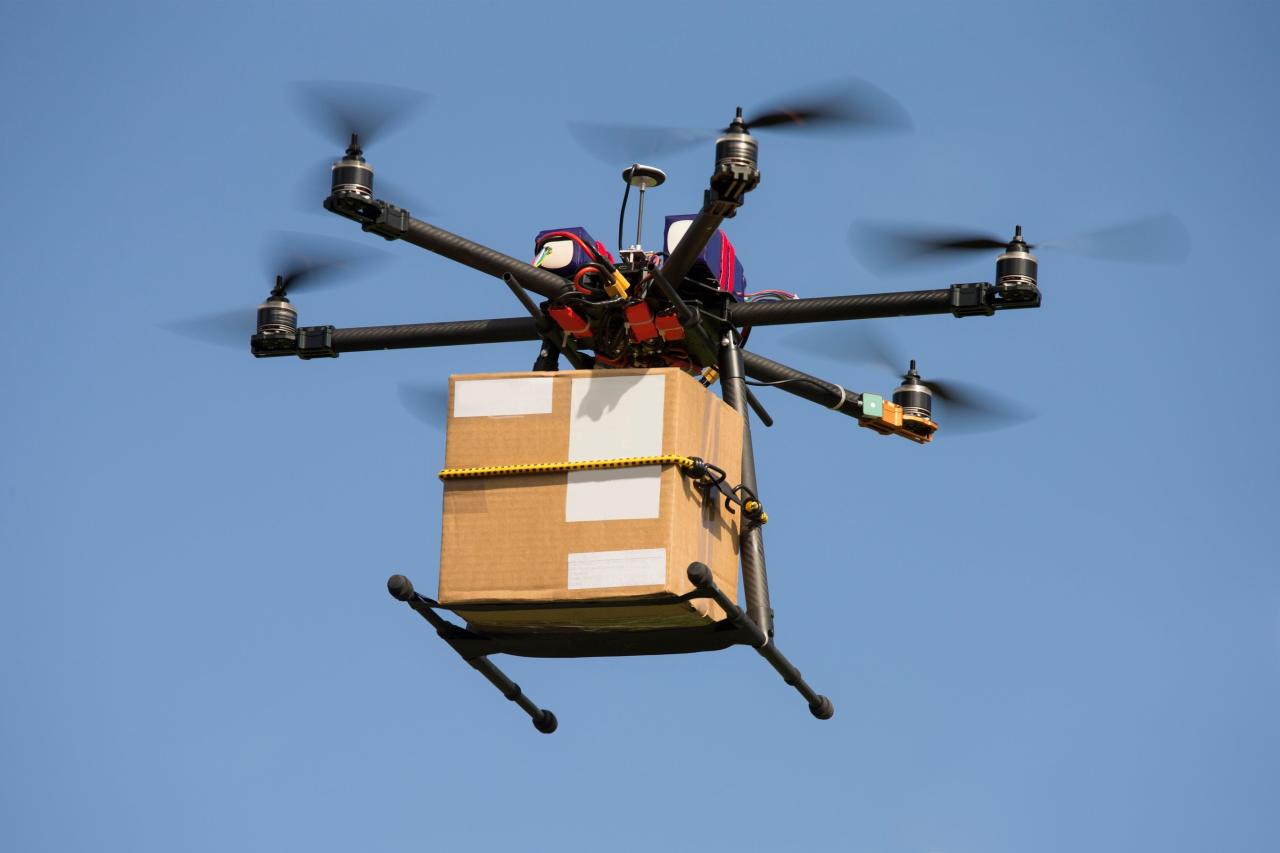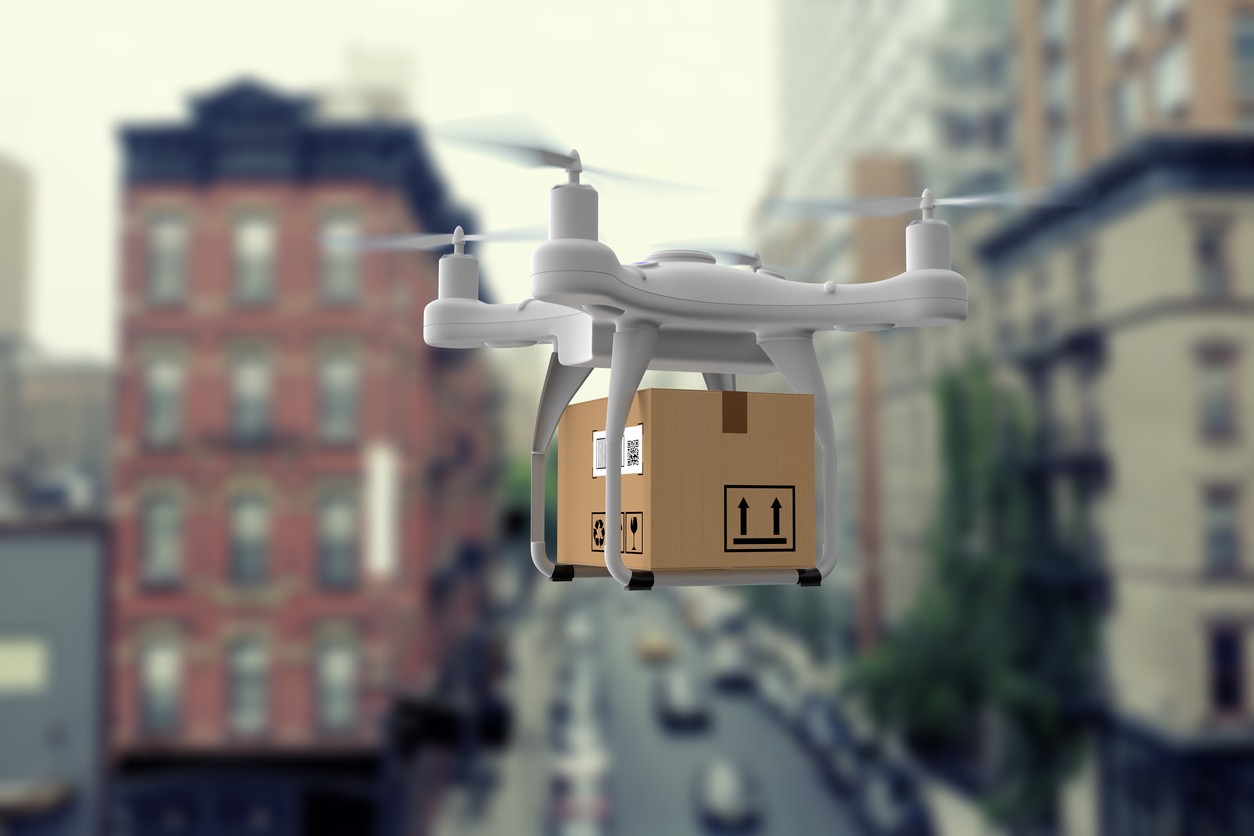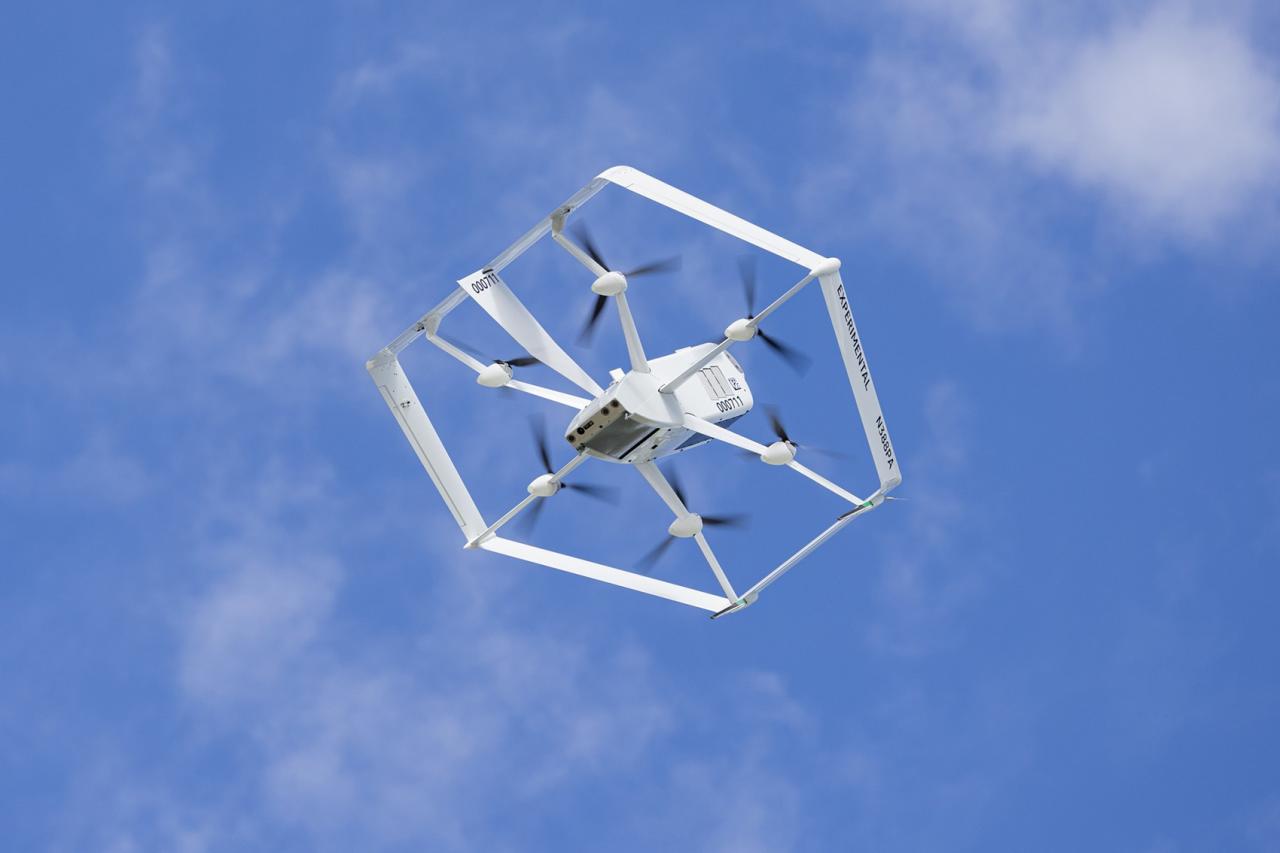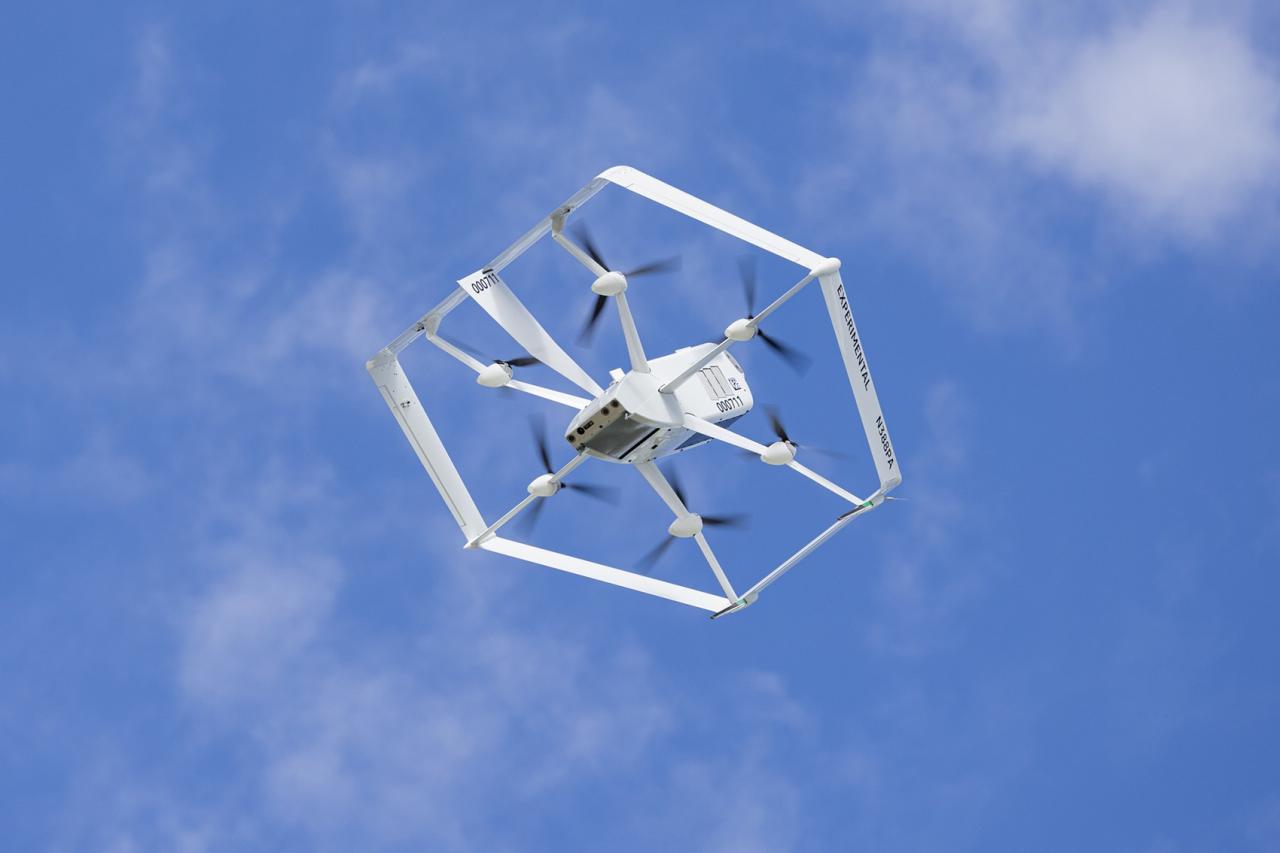Amazon drone delivery locations are rapidly expanding, marking a significant shift in the logistics landscape. This innovative approach promises faster, more efficient deliveries, but its implementation involves complex technological, logistical, and regulatory hurdles. We’ll explore the current state of Amazon’s drone delivery program, examining the factors influencing location selection, the infrastructure required, and the impact on customers and the broader delivery industry.
From the initial selection of suitable areas based on factors like population density and airspace regulations to the technological requirements of the drones themselves, the journey to widespread drone delivery is multifaceted. We’ll unpack the challenges and successes, offering insights into Amazon’s strategy and the future of this disruptive technology.
Current Amazon Drone Delivery Program Status
Amazon’s drone delivery program, officially known as Amazon Prime Air, is steadily expanding its reach and capabilities, though it’s still in a relatively early stage of deployment compared to its overall ambitions. While not yet a widespread service, it represents a significant step towards faster and more efficient delivery methods.Amazon’s drone delivery service currently operates in a limited number of locations.
The exact number of operational areas fluctuates, but it primarily focuses on smaller, geographically defined communities within the United States. These locations are carefully selected based on factors like population density, infrastructure suitability, and regulatory approvals. The company is continuously evaluating new potential locations for expansion.
Geographical Reach of Amazon Drone Delivery
The current geographical reach of Amazon Prime Air is limited to select areas in the United States. The company hasn’t publicly released a comprehensive list of all operational areas, preferring to announce new locations on a case-by-case basis as they become operational. Expansion is gradual, influenced by factors like regulatory approvals, airspace management, and technological readiness. This targeted approach allows Amazon to refine its operations and address any challenges before wider deployment.
Types of Packages Eligible for Drone Delivery
Currently, only smaller packages weighing under a certain limit are eligible for Amazon Prime Air delivery. These typically include everyday items such as books, electronics accessories, and small household goods. The weight and size restrictions are in place due to the payload capacity of the drones and safety regulations. Larger, heavier, or fragile items remain outside the scope of the drone delivery program.
The selection of eligible items is dynamically adjusted as the technology improves.
Technological Infrastructure for Drone Delivery
Successful drone delivery requires a complex interplay of technologies. This includes the drones themselves, equipped with advanced sensors, GPS, and autonomous flight capabilities. A robust network of ground control stations is also necessary for monitoring and managing the drones in real-time. Furthermore, sophisticated software systems are crucial for route planning, package tracking, and maintaining communication with the drones.
The integration of drone technology with existing logistics networks and delivery systems is another essential component. Finally, regulatory compliance and secure airspace management are critical for safe and efficient operations.
Comparison with Other Similar Initiatives
Several companies are pursuing drone delivery solutions, each with varying levels of success and scope. While Amazon is a significant player, it faces competition from companies like Alphabet’s Wing and UPS Flight Forward. These initiatives often differ in their operational strategies, technological approaches, and geographical focus. Some focus on specific niches, such as medical deliveries or rural areas, while others aim for broader urban applications.
The competitive landscape is dynamic, with continuous innovation and refinement of drone delivery technologies. A key differentiator is often the scale of operations and integration with existing logistics infrastructure, a significant advantage for a company like Amazon.
Factors Influencing Drone Delivery Location Selection: Amazon Drone Delivery Locations
Choosing the right locations for Amazon drone deliveries is crucial for efficient and safe operations. Several interconnected factors must be carefully considered to ensure the program’s success and minimize potential risks. These factors range from logistical considerations like population density to regulatory approvals and environmental influences.
Logistical Considerations in Drone Delivery Location Selection
Successful drone delivery locations require a blend of favorable conditions. High population density ensures a sufficient customer base to justify the investment in infrastructure and operations. Existing infrastructure, such as strong internet connectivity for real-time monitoring and control, and suitable landing zones, significantly simplifies deployment. Furthermore, the availability of unobstructed airspace, free from obstacles like tall buildings or power lines, is essential for safe and efficient flight paths.
Finally, proximity to existing Amazon fulfillment centers minimizes transportation time and costs.
Regulatory Approvals and Community Acceptance
Before any drone delivery operation can commence, securing the necessary regulatory approvals from the Federal Aviation Administration (FAA) is paramount. This involves complying with airspace regulations, obtaining necessary permits, and adhering to safety standards. Simultaneously, gaining community acceptance is vital. Addressing public concerns regarding noise pollution, privacy, and potential safety hazards through transparent communication and community engagement initiatives is essential for long-term success.
Without community support, the operational viability of drone delivery programs can be severely hampered.
Impact of Weather Conditions on Drone Delivery Operations and Location Choices
Weather conditions significantly impact drone operations. High winds, heavy rain, snow, or fog can ground drones, leading to delays or cancellations. Location selection, therefore, necessitates considering the local climate and its impact on flight safety and operational reliability. Areas with predictable, favorable weather patterns are naturally preferred for consistent and dependable drone delivery services. For example, locations with less frequent extreme weather events will experience fewer operational disruptions.
Conversely, areas prone to frequent storms might require additional infrastructure or operational strategies to mitigate weather-related delays.
Comparison of Urban vs. Suburban/Rural Locations for Drone Delivery
| Feature | Urban Locations | Suburban/Rural Locations |
|---|---|---|
| Population Density | High, large customer base | Lower, smaller customer base |
| Infrastructure | Potentially complex airspace, existing infrastructure may be challenging to integrate with | Simpler airspace, easier infrastructure integration |
| Regulatory Approvals | More complex due to airspace restrictions and community concerns | Generally less complex, fewer airspace restrictions |
| Weather Impact | More susceptible to weather disruptions due to built-up areas influencing wind patterns | Potentially less susceptible to weather disruptions, but still vulnerable to extreme weather |
Infrastructure and Technology Requirements

Amazon’s drone delivery system requires a robust and sophisticated infrastructure to operate effectively and safely. This includes not only the drones themselves but also the supporting network of facilities and communication systems needed to manage their operation and maintenance. Let’s delve into the specific requirements.
Amazon’s expanding drone delivery locations are pretty cool, right? But safety is key, and recent incidents highlight the need for careful planning. Check out this report on a paris drone crash to see what can go wrong. Understanding these risks is crucial as Amazon continues to roll out its drone delivery network to more cities.
Drone Delivery Infrastructure, Amazon drone delivery locations
The successful implementation of drone delivery hinges on a well-developed infrastructure. This infrastructure encompasses several key components, each crucial for the efficient and safe operation of the delivery network. Charging stations are essential for recharging drone batteries between flights, ensuring continuous operation. Maintenance facilities are needed for routine inspections, repairs, and part replacements, keeping the drones in optimal working condition.
Finally, a reliable and secure communication network is vital for real-time monitoring, control, and data transmission between the drones, ground control stations, and the central Amazon system. This network needs to be resilient to interference and capable of handling large volumes of data. The location and design of these facilities are crucial for minimizing operational costs and maximizing delivery efficiency.
For instance, strategically placed charging stations near delivery hubs could significantly reduce transit time and energy consumption.
Amazon’s Drone Technology
Amazon utilizes a fleet of custom-designed drones possessing a range of advanced features. These drones are engineered for autonomous flight, utilizing GPS and other sensor technologies for navigation and obstacle avoidance. Payload capacity is carefully designed to accommodate various package sizes and weights, optimizing for efficiency and range. Safety is paramount, with built-in redundancy systems and fail-safes to ensure safe landings in case of technical issues or emergencies.
For example, Amazon’s drones are equipped with multiple batteries, allowing for extended flight times and backup power in case of failure. They also incorporate advanced obstacle detection and avoidance systems using cameras, sensors, and sophisticated algorithms. This allows for autonomous navigation and safe operation even in complex environments.
Drone Design Comparisons and Environmental Suitability
Different drone designs cater to various delivery environments. For example, drones with fixed wings are better suited for longer distances and higher speeds, making them ideal for rural deliveries over vast areas. Multirotor drones, with their vertical takeoff and landing capabilities, are more versatile for urban environments with limited space for runways. Hybrid designs combining the advantages of both fixed-wing and multirotor configurations are also being explored to optimize performance across different terrains and conditions.
The choice of drone design is crucial for optimizing delivery efficiency and safety within specific operational contexts. For instance, in densely populated urban areas, multirotor drones might be preferred due to their maneuverability, while fixed-wing drones might be better suited for suburban or rural deliveries where longer distances are involved.
Technological Challenges and Solutions
Several technological challenges need to be addressed for widespread drone delivery adoption. One significant challenge is ensuring reliable communication in areas with limited or unreliable cellular coverage. Solutions include developing alternative communication networks such as mesh networks or satellite communication systems. Another challenge is managing drone traffic and preventing collisions in busy airspace. Advanced air traffic management systems and drone-to-drone communication protocols are crucial for addressing this.
So, Amazon’s planning drone delivery in a bunch of places, right? It’s all about speed and efficiency. But, you know, things can go wrong; check out this news story about a drone crash in Paris – a pretty good reminder of the challenges involved. This highlights the importance of robust safety protocols for Amazon’s drone delivery locations, and why it’s a complex operation to get right.
Weather conditions also pose a challenge, requiring the development of drones capable of operating in adverse weather conditions or the implementation of intelligent scheduling systems to avoid inclement weather. Finally, security is a major concern, requiring robust security measures to prevent unauthorized access or hijacking of drones. This includes encryption, authentication, and anti-tampering mechanisms. Addressing these challenges is crucial for realizing the full potential of drone delivery.
Customer Experience and Impact
Amazon’s drone delivery program is still relatively new, but early customer feedback offers valuable insights into the potential impact on the overall shopping experience. Positive aspects include speed and convenience, while challenges remain in terms of accessibility and unforeseen circumstances. Understanding these aspects is crucial for optimizing the program and ensuring widespread adoption.Customer feedback gathered from pilot programs reveals a generally positive response to the speed and convenience of drone delivery.
Many customers report a significant reduction in delivery times compared to traditional methods, particularly for smaller, time-sensitive items. However, some concerns have also emerged, such as limitations on package size and weight, as well as anxieties surrounding the safety and reliability of drone technology. Addressing these concerns is key to improving customer satisfaction and building trust.
A Typical Drone Delivery Process
Let’s imagine Sarah orders a book from Amazon at 10:00 AM. The order is processed, and if it’s eligible for drone delivery and within the delivery zone, the system automatically routes it to a nearby drone delivery hub. A drone is assigned, and it takes off around 11:00 AM. The drone navigates autonomously using GPS and other sensors, avoiding obstacles and following pre-programmed flight paths.
By 11:30 AM, the drone arrives at Sarah’s designated delivery location—perhaps a designated spot in her backyard—and uses a sophisticated system to gently lower the package. Sarah receives a notification on her phone that the delivery has been completed. The entire process, from order to delivery, takes about an hour and a half, a significant improvement over traditional ground delivery times.
Environmental Impact of Drone Delivery
Drone delivery’s environmental impact is a complex issue. While drones consume less fuel per package compared to delivery trucks, particularly for short distances, the overall environmental benefit depends on several factors. Increased drone use could lead to higher overall energy consumption if not powered by renewable sources. The manufacturing of drones themselves also carries an environmental footprint. However, if powered by electricity from renewable sources, and utilized for deliveries that would otherwise require multiple truck trips, the overall carbon footprint could be significantly reduced compared to traditional delivery methods.
So you’re curious about where Amazon’s delivering packages via drone, huh? It’s pretty cool tech! To get a clearer picture of the current rollout, check out this helpful resource on amazon drone delivery locations to see which areas are already benefiting from this faster delivery method. Knowing these locations helps you understand the expansion of this innovative delivery system and what to expect in the future.
Further research and optimization of drone technology are needed to fully understand and mitigate the potential environmental effects. For example, a study comparing drone deliveries within a densely populated urban area to traditional truck deliveries might show a reduction in overall vehicle miles traveled, leading to a decrease in greenhouse gas emissions.
Impact on Employment and the Last-Mile Delivery Industry
The introduction of drone delivery could significantly impact local employment and the last-mile delivery industry. While some jobs might be displaced, particularly those involving traditional last-mile delivery drivers, new job opportunities are likely to emerge in areas such as drone maintenance, operation, and software development. The impact will vary depending on the scale of drone adoption and the ability of workers to adapt to new roles.
For instance, delivery drivers might be retrained to operate and maintain drones or to manage drone delivery hubs. It’s also possible that drone delivery could create new jobs in related industries, such as drone manufacturing and air traffic management. The overall effect will require careful consideration and potentially government intervention to manage the transition and support affected workers.
Future Expansion and Possibilities

Amazon’s drone delivery program is still in its relatively early stages, but its potential for growth is enormous. We can expect significant expansion in the coming years, driven by technological advancements, increasing consumer demand, and strategic partnerships. This expansion will likely redefine how we receive goods, integrating seamlessly with existing Amazon services and creating new opportunities beyond simple package delivery.The expansion of Amazon’s drone delivery network will likely follow a phased approach.
Initially, we’ll see increased coverage in existing service areas, with more delivery routes and a higher frequency of deliveries. Then, we can expect a geographical expansion into new cities and regions, potentially prioritizing areas with high population density and suitable infrastructure. Think of this as a ripple effect, starting from central hubs and gradually reaching out to more distant locations as technology and regulatory approvals allow.
For example, we might see a significant increase in service areas around major metropolitan areas in the next five years, followed by expansion into more rural communities as drone technology becomes more robust and autonomous.
Integration with Other Amazon Services
Amazon’s drone delivery system will likely become deeply intertwined with its existing ecosystem. Prime members could receive faster, potentially same-day, drone deliveries as a premium benefit, further enhancing the value proposition of Prime membership. This integration could also extend to Amazon’s fulfillment network, with strategically located drone delivery hubs near existing fulfillment centers to streamline the entire delivery process.
Imagine ordering something from Amazon at 10 am and having it delivered by drone before lunchtime – this scenario is becoming increasingly realistic. This synergy will create a more efficient and customer-centric experience.
Impact of Advancements in Drone Technology
Advancements in drone technology will play a crucial role in shaping the future of Amazon’s drone delivery program. Improvements in battery technology will allow for longer flight ranges and heavier payloads. More sophisticated autonomous navigation systems, incorporating AI and machine learning, will enable drones to operate more safely and efficiently in complex environments, including inclement weather conditions. For instance, the development of drones capable of vertical take-off and landing (VTOL) in smaller spaces will allow for delivery to more densely populated urban areas.
This will expand the potential reach of drone delivery significantly. The use of advanced sensors and obstacle avoidance systems will further enhance safety and reliability.
New Applications for Drone Delivery Technology
The technology behind Amazon’s drone delivery program has broader applications beyond package delivery. This technology is versatile and can be adapted to numerous sectors.
- Emergency Medical Supplies: Drones could deliver essential medical supplies like blood, medication, or defibrillators to remote or hard-to-reach areas, potentially saving lives.
- Agricultural Monitoring and Spraying: Drones equipped with sensors could monitor crop health and apply pesticides or fertilizers precisely, optimizing agricultural practices.
- Infrastructure Inspection: Drones can be used to inspect bridges, power lines, and other infrastructure for damage, reducing the need for manual inspections and improving safety.
- Search and Rescue Operations: Drones can be deployed in search and rescue operations to quickly locate missing persons or provide emergency assistance in disaster areas.
Conclusion

Amazon’s drone delivery program is a fascinating case study in technological innovation and logistical problem-solving. While challenges remain, the potential benefits – faster delivery times, reduced environmental impact, and new employment opportunities – are undeniable. As drone technology advances and regulations evolve, we can expect to see a significant expansion of Amazon’s drone delivery network, transforming the way we receive packages.
Question Bank
How much does Amazon drone delivery cost?
Currently, Amazon drone delivery is integrated into standard Prime shipping at no extra cost to the customer, but this may change in the future.
What types of packages can be delivered by drone?
Currently, Amazon’s drone delivery program focuses on smaller, lighter packages. Larger or heavier items are not yet eligible.
How long does a drone delivery take?
Delivery times vary depending on distance and other factors, but generally, drone deliveries are significantly faster than traditional methods for short distances.
What happens if bad weather prevents drone delivery?
Amazon’s drone delivery system is designed to account for weather conditions. In the event of inclement weather, the delivery will be rescheduled.
